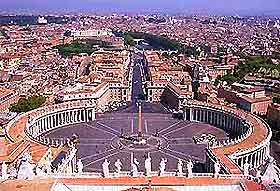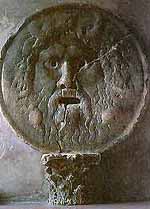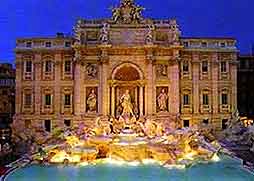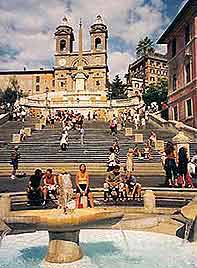Rome Tourist Attractions and Sightseeing
(Rome, Lazio, Italy)

Rome really is like no other city on the planet and the tourist attractions here certainly do come thick and fast. History is everywhere and amongst the commercialism of Rome city centre are some true Italian gems, such as the magnificent Trevi Fountain (Fontana di Trevi) and the equally impressive Spanish Steps (Scalinata di Spagna).
One particularly fun attraction worth looking out for is the Mouth of Truth (Bocca della Verità), which is known to date back to the 17th century and was carved out of Pavonazzetto marble, being most famous for its appearance in the 1953 movie 'Roman Holiday', starring Audrey Hepburn. Other important tourist attractions in Rome include the Capitoline Hill (Campidoglio) area, the Piazza Navona and its beautiful fountains, and the Castel Sant' Angelo (Mausoleum of Hadrian) fortress, which has become known for its towering cylindrical centrepiece.

Mouth of Truth (Bocca della Verità)
Address: Piazza Santa Maria in Cosmedin
Situated in the atrium of St. Mary's in Cosmedin church, this grim marble mask is known as the Mouth of Truth or Bocca della Verità and is actually an ancient drain cover, found half-buried in the Middle Ages. According to popular legend, if anyone puts their hand in the mouth and then does not tell the truth, the mouth will slam shut and prevent them from withdrawing it.
Open hours: daily 09:00 to 19:00
Admission: free
Capitoline Hill (Campidoglio)
Address: Piazza del Campidoglio, Rome
The main attraction at Capitoline Hill is the Piazza del Campidoglio, which was designed by Michelangelo in 1538. At one stage it featured a prominent bronze statue of Marcus Aurelius. Three sides of this well-proportioned square are bordered by the Palazzo dei Senatori and the two museums, the Palazzo dei Conservatori and the Palazzo Nuovo, which are full of famous statues. The Capitoline Hill overlooks the Forum.

Trevi Fountain (Fontana di Trevi)
Address: Piazza di Trevi, Rome 00187
This is one of the most imposing and stunning attractions in the whole of Rome and every day it is visited by crowds of people, many tossing coins into the water. As a result, the fountain actually grosses a large amount of money each year and most of this is donated to charity. In 1730, Pope Clemente XII decided to replace the existing fountain, designed in 1453, with one of much more majesty and asked the city's best artists of that time to help him with the project. The resulting Trevi Fountain is one of undeniable splendour. The carved, marble centrepiece is a large shell pulled by two sea-horses and driven by two tritons, from which a majestic statue representing the ocean emerges. The water is turned off in the early hours of the morning and occasionally at other times for cleaning, so if it is empty when you arrive, make sure that you return to see it in full flow.

Spanish Steps (Scalinata di Spagna)
Address: Piazza di Spagna, Rome
This is possibly one of the most delightful and stunning settings of the baroque period. The spectacular staircase, built in 1723, gets its name from the nearby Spanish Embassy building, which is still the headquarters of Spain's embassy to the Holy See. It was built at the request of Pope Innocent XIII by Francesco De Sanctis, and in the spring large pots of flowering azaleas make a stunning display on the steps.
Piazza Navona
North of Corso Vittorio Emanuele and west of Corso Rinascimento is the Piazza Navona, containing four majestic fountains. The most famous fountain is the 'Fountain of the Four Rivers' which was designed and built by Gian Lorenzo Bernini in 1651.
Mausoleum of Hadrian (Castel Sant' Angelo)
Address: Lungotevere Castello 50, Rome 00193
Tel: +39 (0) 6 68300 183
In the 6th century, the Castel Sant' Angelo was converted into a papal fortress and linked to the Vatican palaces by a series of underground passages, and these have been used by several popes when they felt under threat. The circular Castel Sant' Angelo was originally constructed as the mausoleum of Emperor Hadrian and is now an interesting museum. It is also here that Puccini's Tosca plunged to her death.
Other attractions worth a visit
- Appian Way - A great biking trail, popular with many cyclists
- Basilica di San Clemente - This is actually three churches built one above the other and construction began in 1110 AD
- Basilica di Santa Maria Maggiore - Founded in 432 AD, this church is one of seven pilgrimage basilicas in the world
- Baths of Caracalla (Terme di Caracalla) - 3rd-century ruins of Rome's ancient public bathhouse
- Capannelle - Horseback riding stable
- Catacombs of St. Callixtus (Catacombe di San Callisto) - The first Christian cemetery with the remains of nine popes and saints
- Centro Storico - Many examples of Roman classical and baroque architecture can be found in these narrow streets
- Church of San Luigi dei Francesi - The chapel is filled with famous paintings from leading Italian artist Caravaggio, painted more than 400 years ago
- Church of Santa Maria del Popolo - Renaissance church with baroque additions and various 18th- and 19th-century monuments
- Circus Maximus (Circo Massimo) - Picture more than 150,000 Roman spectators cheering chariot races inside this huge Roman circus, which was built to entertain emperors during the time of Imperial Rome
- Forum of Augustus - This forum was built to celebrate Augustus' victory after the murder of Caesar in 42 BC and includes the large Temple of Mars
- Forum of Trajan - Ruins of a monument to Trajan, who died in 117 AD, much now lies beneath the street
- Il Gelato di San Crispino - Probably the finest ice cream in the whole of Rome, made daily with fresh ingredients
- Janiculum Hill - Scenic hill with breathtaking views across the city
- Jewish Ghetto - Now full of great places to eat, this was originally the area that Pope Paul IV restricted all Jews to live, and used to be surrounded by a wall
- Keats-Shelley House - Small museum devoted to work and memorabilia of Keats and Shelley, also known as Casina Rosa
- Monument to Vittorio Emanuele II - In the Piazza Venezia, this impressive monument was constructed between 1885 and 1911 for the first king of Italy, also known as the Altar of Patriotism
- Palatine - Contains many important relics of great palaces and other ancient structures, such as the Palace of Septimus Severus and the House of Augustus
- Palazzo Altemps - Archeological museum containing the Ludovisi art collection and many ancient sculptures
- Piazza del Popolo - Often considered to be one of the best urban works in Rome, built in the 19th century
- Piazza Navona - An outstanding square featuring Bernini's Fountain of Rivers
- Piazza Venezia - Large, sunny square in the city centre, with majestic monument of King Vittorio Emmanuele II
- San Francesco d'Assisi a Ripa - This church, dedicated to St. Francis of Assisi, was built in 1231 and is still used as a place of worship
- San Giovanni in Laterano (Basilica di San Giovanni) - This Vatican church was the first in Christendom
- Santa Costanza - Built in the 4th century as a mausoleum for Costanza, son of Constantine, it has also been a baptistery and a church
- Santa Pudenziana - The chapel's structure dates back to 140 AD and it was one of the first parish churches in Rome
- St. Paul Outside the Walls (Basilica di San Paolo Fuori le Mura) - This church, built in 1859, has been designated as a National Monument by the Italian Government, due to its wonderful architecture
- Stadium of Domitian - Remains of an ancient stadium that held more that 20,000 seated spectators, constructed in 86 AD
- Trastevere - A lively neighbourhood with the atmosphere of a traditional small Italian town
- Via del Corso - Rome's main thoroughfare, dividing the city from the Piazza Venezia in the south from the Piazza del Popolo in the north
 Rome really is like no other city on the planet and the tourist attractions here certainly do come thick and fast. History is everywhere and amongst the commercialism of Rome city centre are some true Italian gems, such as the magnificent Trevi Fountain (Fontana di Trevi) and the equally impressive Spanish Steps (Scalinata di Spagna).
Rome really is like no other city on the planet and the tourist attractions here certainly do come thick and fast. History is everywhere and amongst the commercialism of Rome city centre are some true Italian gems, such as the magnificent Trevi Fountain (Fontana di Trevi) and the equally impressive Spanish Steps (Scalinata di Spagna).

